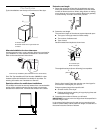
17
TROUBLESHOOTING
First try the solutions suggested here and possibly avoid the cost of a service call...
Clothes are not drying satisfactorily
■ The compact dryer operates at a lower wattage. Expect
longer drying times.
■ Check the following:
Is the lint screen clogged with lint?
Is the lint screen clogged with laundry detergent residue or
other residue? Wash the lint screen. See “Cleaning the Lint
Screen.”
Is the exhaust vent or outside exhaust hood clogged with lint,
restricting air movement? Run the dryer for 5-10 minutes.
Hold your hand under the outside exhaust hood to check air
movement. If you do not feel air movement, clean exhaust
system of lint or replace exhaust vent with heavy metal or
flexible metal vent. See “Installation Instructions.”
Is the exhaust vent crushed or kinked? Replace with heavy
metal or flexible metal vent. See “Installation Instructions.”
Is the automatic cycle ending early? This cycle will end early
if dryer load is not contacting the sensor strips. Level the
dryer. See “Installation Instructions.”
■ Is the dryer located in a room with temperature below
45ºF (7ºC)?
Proper operation of dryer cycles requires temperatures above
45ºF (7ºC).
■ Was a cold rinse water used? Was the load very wet?
Expect longer drying times with items rinsed in cold water
and with items that hold moisture (cottons).
■ Is the load too large and heavy to dry quickly?
Separate the load to tumble freely.
Dryer will not run
■ Check the following:
Is the power cord plugged into a grounded 3 prong outlet?
Has a fuse blown, or has a circuit breaker tripped?
Was a regular fuse used? Use a time-delay fuse.
Is the dryer door firmly closed?
Is the motor running but the drum isn’t turning? This usually
means a belt is broken. Call for service.
Is the indicator light glowing? If not, press the POWER
button.
Was the START button firmly pressed?
Is a cycle selected?
Unusual sounds
■ Has the dryer had a period of non-use?
If the dryer hasn’t been used for a while, there may be a
thumping sound during the first few minutes of operation.
Lint on load
■ Is the lint screen clogged?
Clean lint screen. Check for air movement.
■ Is the load properly sorted?
Sort lint givers (towels, chenille) from lint takers (corduroy,
synthetics). Also sort by color.
■ Is the load too big or too heavy?
Dry smaller loads so lint can be carried to the lint screen.
■ Was the load overdried?
Use correct dryer settings for load type. Overdrying can
cause lint-attracting static electricity. See “Drying, Cycle, and
Temperature Tips.”
■ Was paper or tissue left in pockets?
■ Is pilling being mistaken for lint?
Pilling (surface fuzz) is caused by normal wear and
laundering.
Stains on load or color change
■ Were items soiled when placed in the dryer?
Items should be clean before being dried.
■ Were items properly sorted?
Sort light colors from dark colors. Sort colorfast items from
noncolorfast items.
Items shrinking
■ Was the dryer overloaded?
Dry smaller loads that can tumble freely.
■ Did the load overdry?
Check the manufacturer’s care label. Match dryer setting to
load type. See “Drying, Cycle, and Temperature Tips.”


















